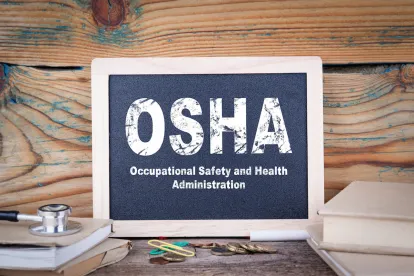Beginning this month, OSHA will be using a new system to weigh and measure enforcement activity in order for the Agency to (1) more accurately allocate resources required to perform enforcement related activities, and (2) continue to develop and support a management system to focus enforcement activities on critical and strategic areas. Under the new system, OSHA will be looking at more than just the time taken to complete an inspection when it measures its total enforcement activity, or “Enforcement Units” for the year. OSHA will also be looking to factors such as the type of hazard it is inspecting and whether it is undertaking the inspection activity pursuant to one of OSHA’s enforcement initiatives. Because weight will now be given to these areas, employers should be prepared for inspections related to high hazards and specific OSHA enforcement initiatives.
Background on OSHA’s Weighting System
Historically, OSHA measured its enforcement activity by looking at the number of inspections that it completed each year. This approach changed in late 2015 when OSHA announced that it would be using an Enforcement Weighting System (EWS) to measure enforcement activity.
In a September 30, 2015, Memorandum to Regional Administrators, then-Assistant Secretary David Michaels announced that OSHA would be implementing a “new system” to “underscore[] the importance of the resource-intensive enforcement activity that is focused on some of the most hazardous workplace issues such as ergonomics, heat, chemical exposures, workplace violence and process safety management.” Beginning in fiscal year 2016, OSHA would not look to the total “number of inspections as the primary metric to measure enforcement activity.” Instead, OSHA would measure inspection activity by assigning varying Enforcement Units (EUs) to different types of inspections, and measure its aggregate enforcement efforts by tallying those EUs. On the low end of the spectrum, non-formal complaint investigations and rapid response investigations would be assigned one-ninth EUs and on the high end of the spectrum, process safety management inspections would be assigned seven EUs and significant cases would be assigned eight EUs.
The New Weighting System
In a September 27, 2019, Trade Release, OSHA announced that it would use a new weighting system beginning on October 1, 2019. Under the new system, which is further described in a memorandum to regional administrators, OSHA will continue to weight inspections but will consider factors in addition to time, such as the type of hazard that OSHA is inspecting and whether it is undertaking the activity pursuant to one of OSHA’s enforcement initiatives.
Going forward, enforcement units are assigned to inspections based on five groupings:
-
Group A includes criminal cases and significant cases and is assigned the highest number of EUs – seven.
-
Group B includes fatalities, catastrophes, and process safety management inspections and is assigned five EUs.
-
Group C includes programmed inspections involving OSHA’s “focus four” high-priority hazards (i.e., caught-in, electrical, fall, and struck-by hazards) and is assigned three EUs.
-
Group D includes programmed inspections under a number of emphasis programs (e.g., amputation, combustible dust, workplace violence, and heat hazards, Site-Specific Targeting, among others), and is assigned two EUs.
-
All other inspections are encompassed by Group E and assigned 1 EU.
OSHA intends for the changes to the weighting system to “support a management system that focuses enforcement activities on critical and strategic areas where the agency’s efforts can have the most impact.”
Implications
In light of this announcement, employers should expect OSHA’s inspection activity to reflect a renewed emphasis on high hazard areas and OSHA’s enforcement initiatives. Employers should review their plans for preparing for and managing an OSHA inspection or develop a plan if one is not in place. Additional tips for handling an OSHA inspection are available here.






 />i
/>i

